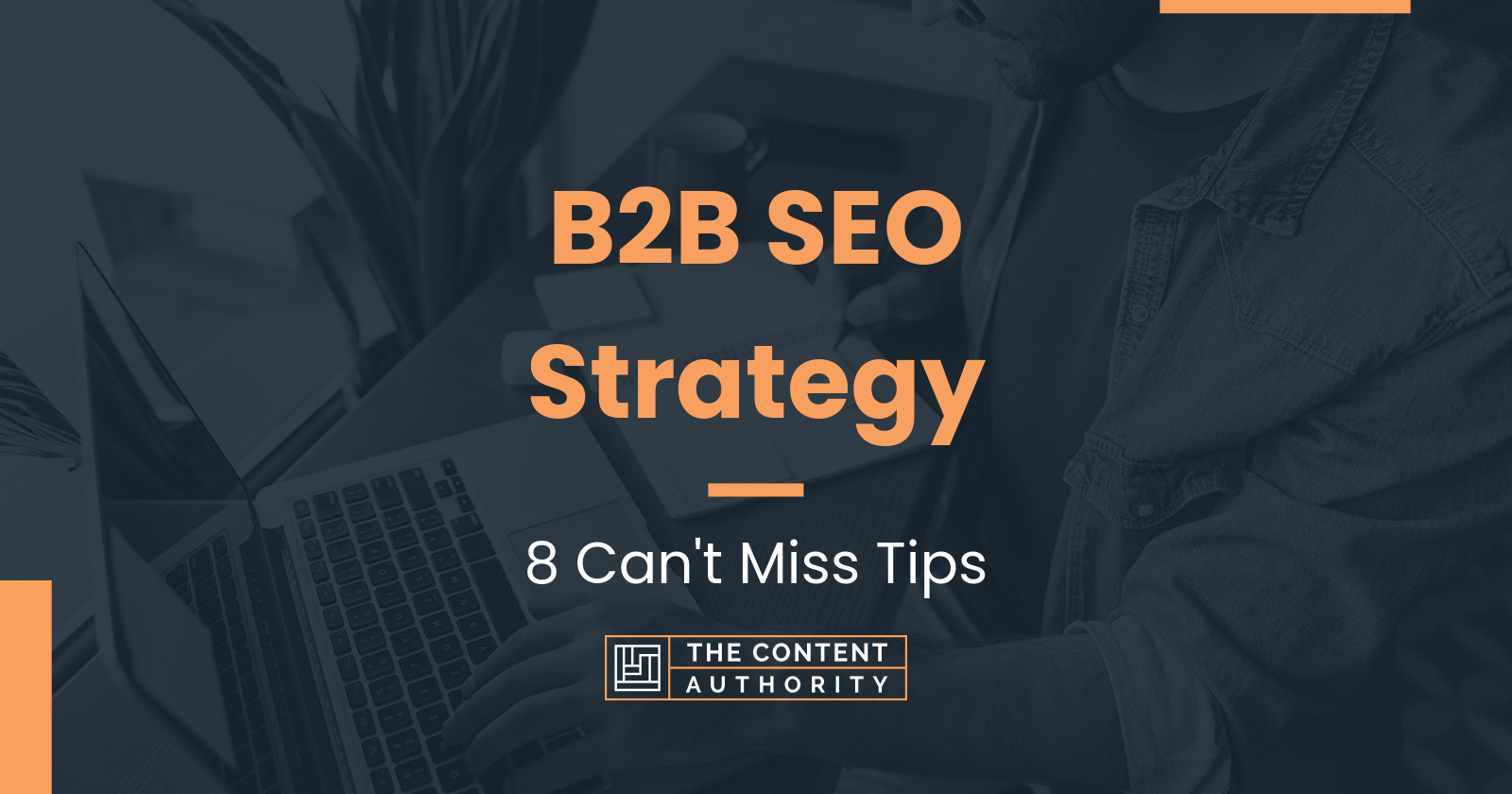That’s what an SEO audit checklist entails. You should also run a content audit at this point, checking for and eliminating duplicate content.
Have your SEO agency or in-house team run an in-depth check of your website and content to discover any problems.
They should:
- Create a technical roadmap.
- Get to the root of your SEO issues.
- Implement practical solutions to solve those issues.
Pro tip: You can use many SEO tools, such as Ahrefs or SEMrush Site Audit. They both outline specific SEO problems and have easy-to-read reports:An effective B2B SEO strategy can boost your awareness and reputation significantly.
You’re on the right page to learn how to power up your SEO efforts. You’ll learn:
- Eight results-driven tips that skyrocket your SEO
- Practical steps to implement them
We’ll also build and analyze several examples.
Let’s dive in:
1. Don’t Skip the Technical Audit
In the year 2023, it’s more important than ever for your website to be:
- Responsive
- User-friendly
- Easy to index by search engines
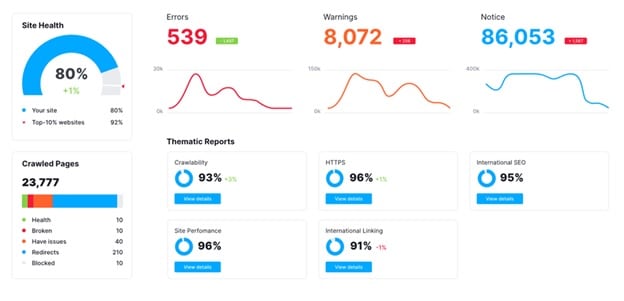
2. Learn from Your Competitors
B2B companies face specific challenges:
- The B2B space is crowded with businesses that offer high-performing solutions.
- Your audience does in-depth research and lacks loyalty; your customers will immediately change partners if they find a higher-quality product with increased functionality at a lower price.
That means you still can’t neglect your competition in 2023, especially if they rank above you on search engines.
Here’s how you do it.
- Shortlist your rivals.
- Direct competitors: Offer the same products.
- Indirect competitors: Offer different products but can potentially satisfy the same B2B clients’ needs.
- Companies who compete for your audience’s attention: Address the same audience, ranking for the same keywords.
You can find these rivals by analyzing your industry knowledge and sales team data or using an online SEO tool.
- Find your competitors’ best-performing content assets and campaigns.
Remember: If your rivals’ SEO strategy skyrockets their traffic, that strategy will likely work for you.
For example, SEMrush allows you to zero in on these strategies, analyzing Top Pages in the Trends category.
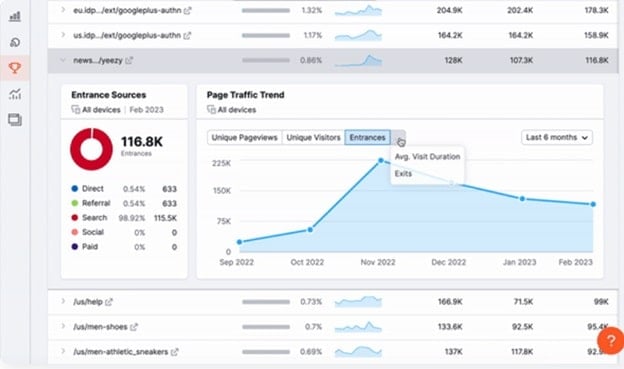
But many other SEO tools offer in-depth traffic analytics data you can use.
Identify:
- Key traffic sources
- Special SEO or paid ad campaigns that increase their organic traffic
- Specific items that skyrocket that traffic (e.g., an industry study, a new tool or calculator)
Pro tip: Focus on traffic quality, not just quantity. These SEO tools allow you to see your competitors’ conversions, a benchmark for traffic quality.
- Use these insights.
Competitive gap analysis allows you to:
- Learn from your rivals’ mistakes.
- Improve your SEO strategies based on their successful campaigns.
- Change your marketing objectives.
3. Build a Customer Value Profile [Not Just an Ideal Customer Persona]
In B2B, it’s essential to focus on the customer value profile, not just the ideal buyer persona.
- In B2C, you can address Jim, the 37.5-year-old football-loving dad with 2.3 kids, a dog, and a Ford, but:
- In B2B, your customers have diverse backgrounds, ages, interests, and family lives.
Imagine you’re selling a B2B SaaS product, such as a team recruiting tool. How would you define your target customer?
| Option A | Option B |
| Using the standard socio-demographic and psychographic characteristics, such as:
● Age ● Gender ● Interests ● Location ● Etc. |
By analyzing their:
● Function inside the company (likely HR or manager) ● Their needs (fast, seamless process, picking the right candidates) ● How your company can address those challenges
|
The answer is option B.
That is your customer value profile.
Remember: Focus on your B2B buyers’ needs and develop a one-sentence value proposition to showcase how your products can meet those needs.
Get that data by analyzing:
- Sales team discussions
- CRM insights
- SEO tools that help you understand your customers’ user sentiment
- Website behavior analytics
- Info from your social media listening tools
4. Set Clear Goals [and Don’t Forget the KPIs]
A successful B2B SEO strategy is based on SMART goals and clear KPIs, whether it’s 2023 or 2123.
So once you finished your research, don’t just jump into the strategy. Understand:
- What you want to achieve.
- How you will measure your results.
Let’s say our SEO strategy aims to increase the downloads for our recruiting app.
In this case, we’ll monitor:
- Monthly traffic and bounce rates on money pages
- Monthly traffic and bounce rates on pages ranking for transactional or commercial keywords
- Cost per acquisition
- Conversion rate
If your SEO goal is to increase awareness, you will maybe focus on monthly traffic and the number of new unique visitors.
Just remember to set those correct KPIs according to your objectives.
5. Address Your Audience [and Your Other Audience]
You may not realize this, but if you’re in B2B, you have two audiences (and no, we’re not just talking about different segments).
You have to address your potential:
- B2B customers: They will buy your products, so you have to create relevant, high-quality content that persuades them to become your clients. That useful content also helps you rank higher on search engines because they:
- See you’re a relevant expert in your field.
- Can index your content better because you’re ranking for keywords with high-search intent.
- B2B link partners: They link back to your resources from their websites, creating authoritative links. Engaging with trusted link building companies can significantly enhance this aspect of your SEO strategy, ensuring high-quality backlinks that boost your site’s authority and search engine ranking. It’s important to note that the cost per backlink on a reputable website can easily exceed $1,000, reflecting the value and impact of quality backlinking in a comprehensive SEO strategy. These links indicate to Google and other search engines that your website is a valuable resource worth ranking higher.
You can find these link partners by:
- Searching for them on Google.
- Analyzing expert websites in your niche.
- Looking at competitors’ backlinks.
Side note: Tools like Ahrefs help you find link partners in your niche that cite your competitors and filter them according to key variables:
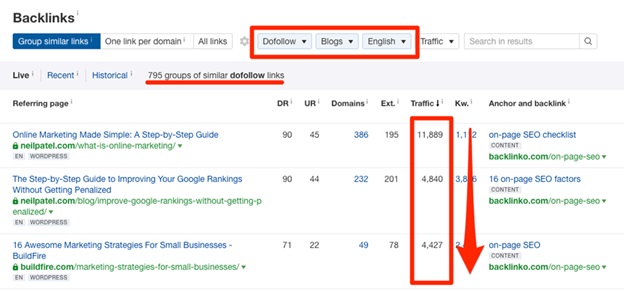
Now, aim to write content that addresses both your potential customers’ and link partners’ search intents.
That brings us to the next point:
6. Choose the Right Keywords According to Search Intent [and Sales Funnel]
You need to hone your B2B keyword research very carefully to produce SEO-friendly content that:
- Ranks in Google.
- Brings you valuable backlinks.
And there are different tactics, but the common thread in 2023 still is figuring out what your audiences are interested in.
- For your customers: Build a customer journey to create relevant content for different sales funnel stages. Your content marketing strategy should include:
| Type of content | Type of keywords | Sales funnel stage | What your customers are doing |
| Informative | Informational | Top of the funnel (TOFU) | Becoming aware of their needs or discovering potential solutions |
| Analytical; product-focused | Commercial and navigational | Middle of the funnel (MOFU) | Evaluating their options |
| Purchase-oriented | Transactional | Bottom of the funnel (BOFU) | Making their purchase decision |
- For your potential link partners: Use an SEO tool to research industry trends and topics that interest these experts in your niche.
Let’s explain.
You have a business-to-business watercooler company. Here’s how to pick the right keywords for each stage of the sales funnel:
- Take the previous steps to identify the content and keywords that increase your competitors’ organic traffic and backlinks.
- Shortlist these ideas in an Excel doc, focusing on keywords that fit your customer value proposition.
- Do extra research on Google’s “People also ask,” niche Reddit communities, and Quora.
- Make a list of keywords and arrange them according to the sales funnel stages.
TOFU (content that focuses on basic information):
- Water cooler technology
- Water cooler maintenance
- Water cooler benefits
- Water cooler energy efficiency
- Water cooler environmental impact
- Water cooler regulations
MOFU (content focusing on assessments):
- Water cooler brands
- Water cooler distributors
- Water cooler suppliers
- Water cooler comparison
- Water cooler product reviews
BOFU (content focusing on purchase decision)
- [Company Name] pricing
- [Company Name] specifications
- [Company Name] warranty
- [Company Name] certifications
Now that you have a list of keywords, you can use an SEO tool to pick specific topics that also interest your potential link partners.
Pro tip: Since we’re talking about can’t-miss SEO tips for 2023, remember that AI tools like ChatGPT can speed up your keyword research process if you give them the right commands.
Let’s return to our water cooler company:
You can maybe realize that authoritative content creators are interested in the environmental impact of water coolers.
So when you create informational content about water cooler energy efficiency, you can bring up that too:
- You can create some free tools to assess that environmental impact.
- You can produce content (i.e., industry studies, statistics) gauging water coolers’ ecological impact.
That brings us to the next point:
7. Create Strategic, SEO-Friendly Content
You can write a dissertation paper on the best types of B2B content for search engine optimization and best practices.
You probably already know the key elements of a perfect article:
- Relevant, high-quality long-form content brings more conversions.
- You shouldn’t stuff your articles with keywords.
- Add visuals and make your content easy to skim through.
- Hone your internal link structure to avoid orphan pages and to make your website easier to crawl by search engines.
You also have a wide range of content types to choose from:
- Case studies
- Industry research
- Whitepapers
- How-to guides and videos
- Webinars
- And more
Even email marketing can boost your online traffic and shares, thus improving your SEO considerably.
But here are some tips that will help you in 2023 and beyond:
- Leverage user-generated content: People buy from people, and your B2B clients – albeit key decision-makers in companies – are people too. Studies show UGC and influencer-generated content is more credible than branded content, so partner with creators that can transfer their credibility.
- Create link-baits: Think of industry statistics, tools, and calculators missing from your niche. Your competitive and audience analyses come in handy here because you now know:
- What your potential customers need
- What your potential link partners link to
- What your competitors lack
Just look at how much traffic and backlinks Ahrefs tools bring:
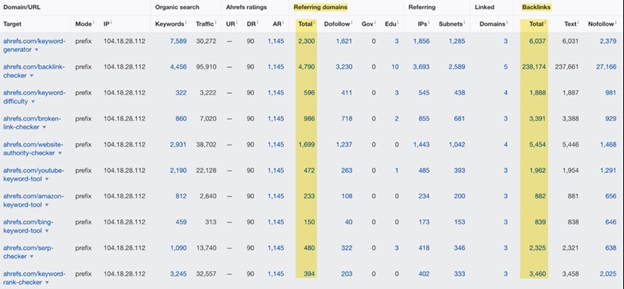
- Make your content interactive: Add interactive elements to your content, such as quizzes or checklists.
Let’s say you’ve created accounting software. You can:
- Create videos of existing customers sharing insights about your software.
- Build free tools your competitors aren’t sharing, such as free marketing budget calculators. Your potential link partners will quote these tools massively because it responds to their audience’s needs.
- If you hold a webinar, do a live demonstration during your presentation by analyzing and solving one of your participants’ problems in real-time.
8. Focus on Off-Page SEO
Off-page SEO is as important as on-page and technical SEO. But if you’re here, you already have those underway.
Off-page SEO entails techniques and strategies focusing on external elements that affect your search engine visibility. If you improve those elements, your visibility and ranking increase.
So, focus on:
- Link-building: This involves acquiring high-quality backlinks from other websites to your own. Backlinks indicate the authority and relevance of your website to search engines, helping you rank higher in SERPs. We already discussed a bit about finding the best link partners above.
- Social media: Social media platforms like Twitter and LinkedIn promote your website and build relationships. These channels increase your organic traffic so that search engines deem your website more relevant, thus increasing your ranking. You can also find and connect with multiple link partners on social media. Plus, your social platforms are a treasure trove of high-intent keywords and relevant topics.
- Online reputation management: Monitor and manage your online reputation by responding to reviews and comments. The goal is to build positive relationships with your customers and other online communities to increase organic traffic.
- Local SEO: Optimize your online presence for local search to attract local customers and improve your search engine ranking.
- Review sites: Many review websites, such as Google My Business, can promote your business and build customer trust.
Wrapping Up
This guide showed you practical tips to power up your B2B SEO strategy.
Remember that in 2023, content is still king, queen, and everything in between. So, aim to solve your customers’ needs through relevant content, but also focus on what potential link partners want to share.
And to really optimize your SEO efforts, solve all technical issues, and don’t neglect off-page SEO.
Follow this advice, and your B2B SEO strategy will help you achieve all your most coveted marketing goals.
Author bio:
David is a serial entrepreneur and CEO of Breeeze.co, an SEO services company that helps 20+ agencies and businesses succeed by providing SEO services that drive growth for their clients’ sites on Google and beyond.

